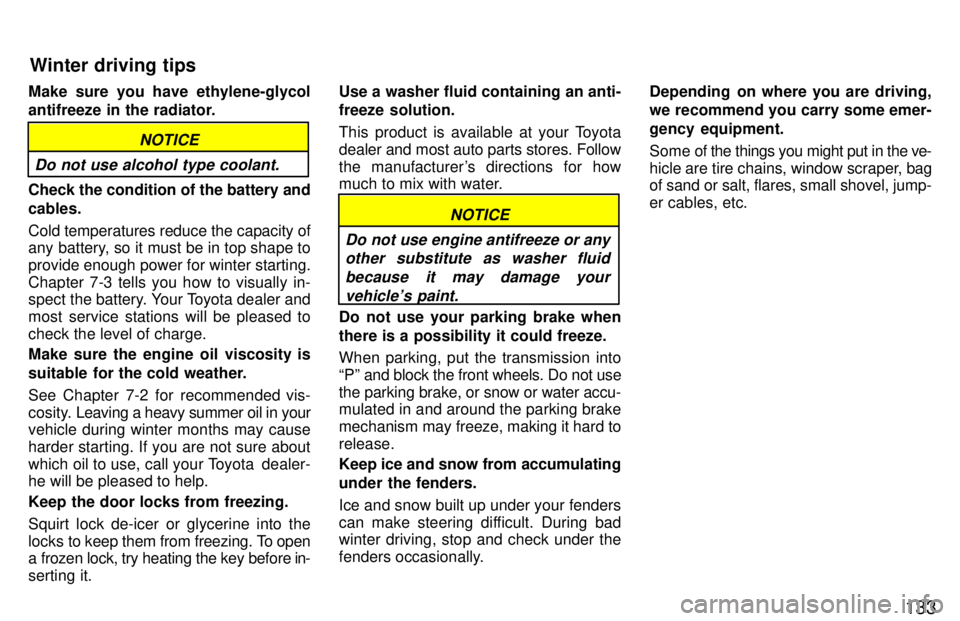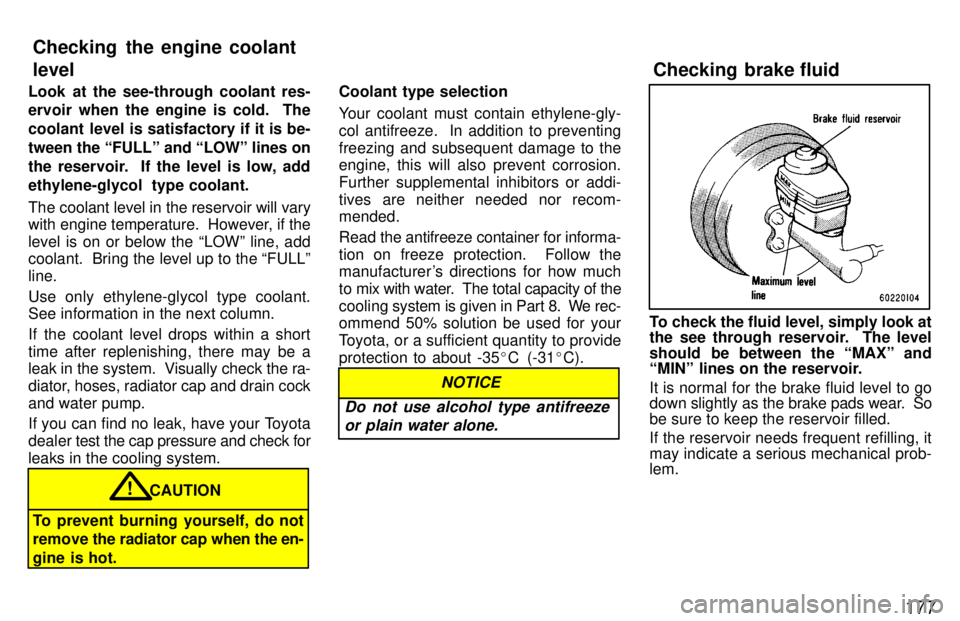Page 108 of 159

133
Make sure you have ethylene-glycol
antifreeze in the radiator.
Do not use alcohol type coolant.
NOTICE
Check the condition of the battery and cables. Cold temperatures reduce the capacity of
any battery, so it must be in top shape to provide enough power for winter starting.Chapter 7-3 tells you how to visually in-
spect the battery. Your Toyota dealer and
most service stations will be pleased tocheck the level of charge.
Make sure the engine oil viscosity is
suitable for the cold weather.
See Chapter 7-2 for recommended vis-
cosity.
Leaving a heavy summer oil in your
vehicle during winter months may cause
harder starting. If you are not sure about
which oil to use, call your Toyota dealer- he will be pleased to help. Keep the door locks from freezing. Squirt lock de-icer or glycerine into the
locks to keep them from freezing. To open
a frozen lock, try heating the key before in-serting it. Use a washer fluid containing an anti-
freeze solution.
This product is available at your Toyota
dealer and most auto parts stores. Follow
the manufacturer's directions for how
much to mix with water.
Do not use engine antifreeze or any
other substitute as washer fluid
because it may damage yourvehicle's paint.
NOTICE
Do not use your parking brake when there is a possibility it could freeze. When parking, put the transmission into
Pº and block the front wheels. Do not usethe parking brake, or snow or water accu- mulated in and around the parking brake
mechanism may freeze, making it hard torelease. Keep ice and snow from accumulating
under the fenders.
Ice and snow built up under your fenders
can make steering difficult. During bad winter driving, stop and check under the
fenders occasionally. Depending on where you are driving,
we recommend you carry some emer- gency equipment.
Some of
the things you might put in the ve-
hicle are tire chains, window scraper, bag of sand or salt, flares, small shovel, jump- er cables, etc.
Winter driving tips
Page 146 of 159

177
Look at the see-through coolant res-
ervoir when the engine is cold. The
coolant level is satisfactory if it is be-
tween the FULLº and LOWº lines on
the reservoir. If the level is low, add
ethylene-glycol type coolant.
The coolant level in the reservoir will vary
with engine temperature. However, if the
level is on or below the LOWº line, add
coolant. Bring the level up to the FULLº line. Use only ethylene-glycol type coolant. See information in the next column.
If the coolant level drops within a short
time after replenishing, there may be a
leak in the system. Visually check the ra-
diator, hoses, radiator cap and drain cock
and water pump.
If you can find no leak, have your Toyota
dealer
test the cap pressure and check for
leaks in the cooling system.
To prevent burning yourself, do not
remove the radiator cap when the en-
gine is hot.
CAUTION! Coolant type selection
Your coolant must contain ethylene-gly- col antifreeze. In addition to preventingfreezing and subsequent damage to the
engine, this will also prevent corrosion. Further supplemental inhibitors or addi-
tives are neither needed nor recom- mended.
Read
the antifreeze container for informa-
tion on freeze protection. Follow the
manufacturer 's directions for how much
to mix with water. The total capacity of the
cooling system is given in Part 8. We rec-
ommend 50% solution be used for your
Toyota, or a sufficient quantity to provideprotection to about -35 �C (-31 �C).
Do not use alcohol type antifreeze
or plain water alone.
NOTICE
To check the fluid level, simply look at
the see through reservoir. The level
should be between the MAXº and
MINº lines on the reservoir. It is normal for the brake fluid level to go
down slightly as the brake pads wear. So
be sure to keep the reservoir filled. If the reservoir needs frequent refilling, it may indicate a serious mechanical prob- lem.
Checking the engine coolant level
Checking brake fluid
Page 153 of 159

+25 -15
196
Fuel type:
Unleaded gasoline, Research OctaneNumber 91 (Octane Rating 87) or higher
Fuel tank capacity, L (gal., Imp. gal.):
95 (25.1, 20.9) ENGINE
Valve clearance (engine cold), mm (in.)
Intake 0.15 '0.25 (0.006 '0.010)
Exhaust 0.25 '0.35 (0.010 '0.014)
Spark plug type: NIPPONDENSO K16R-U
NGK BKR5EYA
Spark plug gap, mm (in.): 0.8 (0.031)
Drive belt tension measured with Bor-
roughs drive belt tension gauge No.
BT-33-73F (used belt), lbf: 80 + 20
ENGINE LUBRICATION Oil capacity (drain and refill), L (qt., Imp. pt.)
With filter 7.2 (7.6, 6.3)
Without filter 6.9 (7.3, 6.1)
Oil grade: API SH, Energy-Conserving IIº multi-
grade engine oil or ILSAC multigrade
engine oil is recommended. Recommended oil viscosity (SAE):
COOLING SYSTEM
Total capacity, L (qt., Imp. qt.):
With rear heater13.7 (14.5, 12.1)
With front and rear heater 14.7 (15.5, 12.9)
Coolant type: With ethylene-glycol antifreeze (Do not
use alcohol type.)
BATTERY ÐMaintenance type battery
Specific gravity reading at 20 �C (68 �F):
1.280 Fully charged1.180 Half charged 1.080 Discharged
Service specifications
Fuel